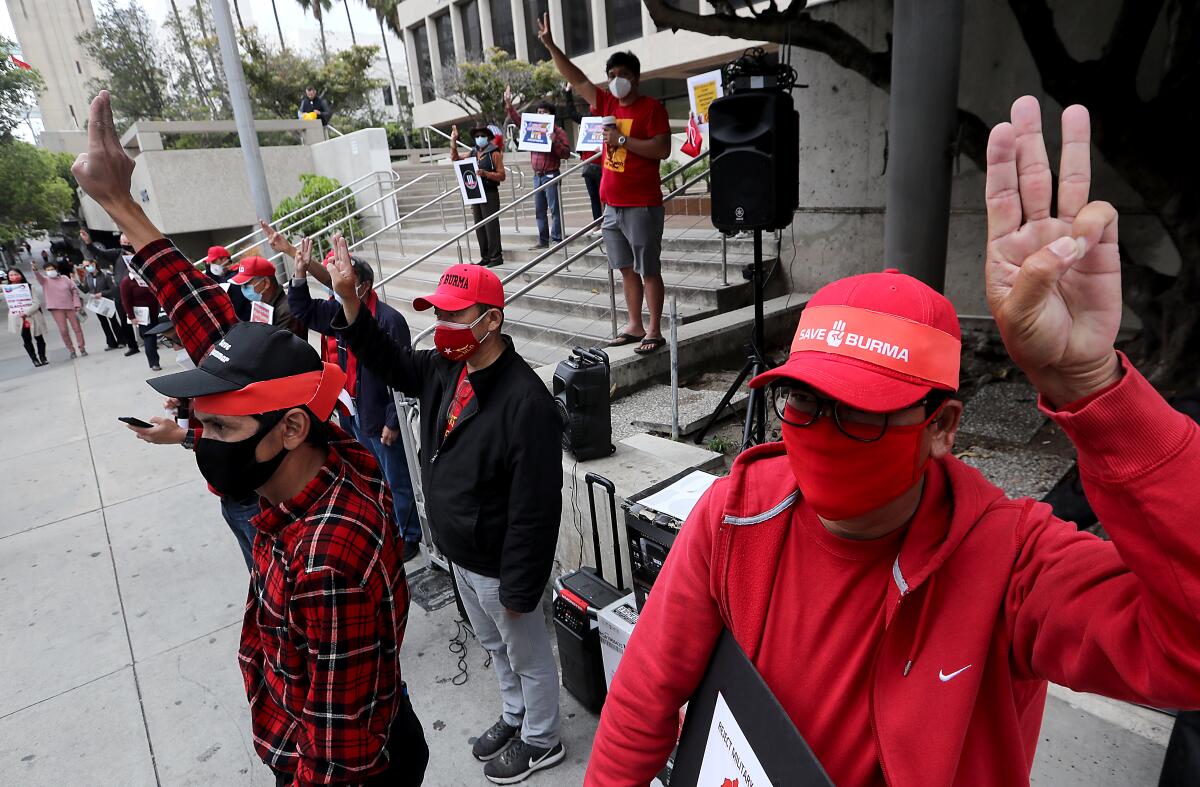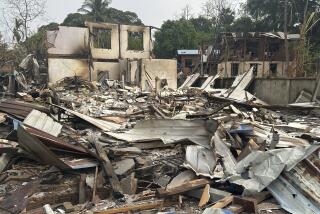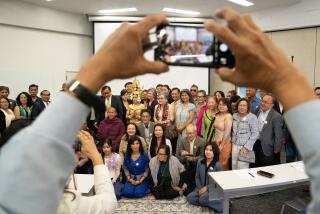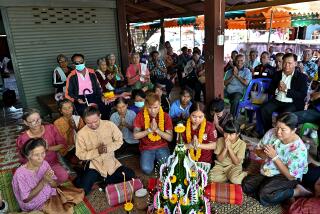‘A dangerous time’ in Myanmar: Burmese in California struggle for answers, attention

Banny Hong sighed as he sat at his Burmese restaurant on a recent weekday, recounting the violence that has swept through his homeland since a military coup four months ago.
Two portraits of Myanmar’s civilian leader Aung San Suu Kyi decorated the wall before him, flanking a photograph of Yangon, the nation’s largest city.
“It’s a dangerous time there,” he said as two masked employees cleaned tables and swept the floors before his Stanton eatery, Irrawaddy Taste Of Burma, opened for the day. “A lot of untold stories. Missing bodies. It’s a devastating moment. I am very desperate.”
Hong’s friends from his university days still live in Myanmar, also known as Burma, which Hong left in 1987. He worries for their safety and believes that only the United States can help bring an end to the violence that so far has resulted in an estimated 750 civilian deaths, widespread arrests and street protests amid a military crackdown in the Southeast Asian country.
“Even my customers are asking about it,” the 55-year-old said.
Members of California’s Burmese diaspora have protested across the state since Myanmar’s military leadership seized control of the government on Feb. 1, detaining Suu Kyi and other civilian leaders and claiming without evidence that recent elections, which Suu Kyi’s party won in a landslide, were riddled with fraud.
Despite international condemnation and strikes that have brought the nation’s economy near collapse, the military has maintained a state of emergency and intensified its repressive tactics.
For the small Burmese American community in California, the coup has stoked fears that Myanmar’s decades-long efforts toward limited democracy and individual freedom could be over.
The number of Myanmar expatriates is estimated to be 30,000 statewide. Most Burmese Americans live in large metropolitan areas including Minneapolis-St. Paul, Indianapolis, New York, Dallas, Los Angeles and San Francisco.
Between the 2002 and 2019 fiscal years, most refugees who migrated to the U.S. came from Myanmar — about 177,700 — according to the Pew Research Center.
In all, roughly 189,000 people of Burmese descent live in the U.S., the Pew data show. The first large influx of immigration to the United States began in the 1960s, when military rule was first established. Another landed around the time of the so-called 8888 Uprising in 1988, a movement led by students now known as the 88 Generation.
About 25% of the U.S. Burmese population lives in poverty, 2019 Pew data found. Compared with the Asian American population as a whole, foreign- and native-born Burmese Americans collectively have less education and lower English proficiency, the data show.
Many in enclaves in Orange County, San Francisco and the San Gabriel Valley, like Hong, hold ties to Myanmar through family and friends who never left, some of whom are at risk or in hiding. For members of the diaspora, the goal of the dozens of protests they’ve held is to push for U.S. divestment from Burmese companies — many owned by the military — in hopes of depriving the government of its income sources.
The rallies also serve as a means to raise awareness about the coup — the deaths of hundreds in the streets and the restriction of freedoms in a country that activists say most Americans couldn’t point to on a map, let alone advocate for.
“When I first got here, people would ask where I’m from. I would say Burma or Myanmar and people would say, ‘Burma in San Diego?’” said Kristy Thu, an interior design student at Mt. San Antonio College in Walnut. “People have been clueless about where Myanmar is. No one knows about [it], so it’s just harder for us to get through to the world’s attention.”
Before the coup, Thu and her family in Myanmar would talk every day. The constant communication was a source of comfort for her as she pursued her studies. “That happened until my dad was given an arrest warrant,” Thu said.
Her father, a singer in Myanmar, used his platform to speak out against the coup. He has been in hiding since the military put out a warrant for his arrest several weeks ago and surrounded their family home one night around 11, Thu said.
“My dad doesn’t want me to worry too much. He says he will try his best to stay out of their way, but there is a long fight and it’s not going to be over in just a week or two,” the 23-year-old said. “My whole family is dispersed and hiding in different places. It’s just really traumatizing.”
Some days, Ethan Myint feels so overwhelmed by the coup that he has to disconnect himself from news about Myanmar that pours through social media and group chats and other sources. At times, he said, the anxiety is crippling.
“This battle against the Tatmadaw is generations long,” said Myint, 23, using the name of Myanmar’s military. “My parents fought them, my grandparents fought them. It’s a dictatorship and it’s a battle, and because of that it’s just a part of my identity.”
Myint, a refugee who escaped Myanmar with his mother when he was 9, said that raising awareness of the coup is important because the people of his homeland “deserve to be free and live their lives.”
He’s been moved by scenes of young protesters taking to the streets and being met by soldiers and police wielding water cannons and firing live rounds.
“They’re students younger than myself doing these things, and this is the message we try to get out as much as possible,” he said. “When you think of a teen or someone in their early 20s, you don’t think of someone risking their lives. They’re supposed to be experiencing love or messing around with friends.”
At the start of the coup, social media from inside Myanmar brought updates on arrests, deaths and crackdowns. But since the military took control of the internet, many in the diaspora haven’t been able to see what is happening on the streets in real time, said Thet Lin Tun, president of UCLA’s Burmese Student Assn.
“It is a tragedy and it’s an abomination,” Lin Tun said. “People are getting burned alive. They’re getting hit with [rocket-propelled grenades]. ... I just can’t believe the people of Myanmar are being treated like this by the people who have been sworn to protect them.”
Myanmar’s elected leader, Suu Kyi, became an icon of democracy while under house arrest for nearly 15 years, winning the Nobel Peace Prize. But she has been condemned internationally for her support of the military’s slaughter of Rohingya Muslims starting in 2017.
President Biden imposed sanctions on Myanmar’s military commanders in February. Saying the military must “respect democracy,” he announced that he would block army commanders from accessing
$1 billion in assets in the U.S. and target individuals for restrictions that would bar them from doing business with U.S. citizens or entities.
Lin Tun, 22, feels as though Myanmar and the Burmese diaspora garner less attention from the international community and mainstream media than other ethnic groups with better-known struggles, such as Armenian Americans, who have fought for decades for recognition of the Armenian genocide at the hands of the Ottoman Turks during World War I.
“I honestly don’t know why,” said Lin Tun, who moved to California in 2017 to study political science. “It’s a question I have been wondering about with my fellow Burmese. We have been wondering how can we fix it.”
Jonathan Liljeblad, a researcher at Australian National University, said one reason the diaspora in the U.S. has struggled to gain attention is that it is “nowhere near as influential as the Chinese, Korean or even Vietnamese American community.”
When he migrated to Los Angeles as a child in the late 1980s, “there was no such thing as a Burmese restaurant ... whereas there was no end to Chinese restaurants and Vietnamese restaurants.” That, alongside the lack of a culture of activism among many immigrants from Myanmar, he said, has hampered their ability to raise awareness.
“There is a general disposition toward a low profile to avoid drawing attention,” Liljeblad said. “As a result, it’s a struggle to create a sense of unified activism in the U.S.”
Lin Tun, the UCLA student, said he has noticed a lower level of interest from American-born Burmese because many of them are “detached” from Myanmar and have never visited. There is also a split along generational lines when it comes to deciding the best way to make other Americans aware of the unrest, he added.
“The youth want to communicate more in English to convince the rest of American communities to stand up and fight for them,” he said. “The older people are more keen to talk in Burmese because they are stronger in Burmese and it also feels better to let out their feelings in Burmese. There’s a clash when it comes to that.”
The community is working together despite that, he said. But he noted that different generations of activists have not only different tactics but different goals.
“Youth typically cares more about awareness, humanitarian help, divestment,” Lin Tun said. “The older generation, they care more about harsher sanctions, and a considerable amount want military intervention” by the U.S.
Ii Maung, a mechanical engineer who has helped organize the protests, said that the community’s voice is unified but just starting to form. Her brother, an author who owns a publishing company and is actively protesting the coup, is in hiding, Maung said.
“He called me once and my parents were with me. He asked about them, and my mom couldn’t even talk because she was shaken,” said Maung, who moved to the U.S. in 2001.
To her, the fight for democracy in Myanmar is not just a Burmese cause, but a global one battling a “crime against humanity.”
“In Burma, you cannot go out there and express yourself with freedom. We lost that,” she said. “That’s why it’s important to us. We are fortunate enough to do that here and raise awareness where they cannot.”
More to Read
Sign up for Essential California
The most important California stories and recommendations in your inbox every morning.
You may occasionally receive promotional content from the Los Angeles Times.











